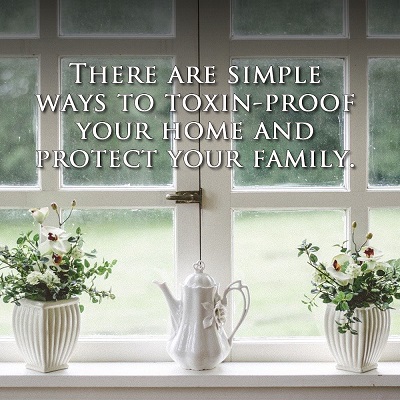 We all want our families to be protected from harmful bacteria and viruses in our homes. To do that most people keep a constant supply of various cleaning materials that we believe will help us keep our home free from germs.
We all want our families to be protected from harmful bacteria and viruses in our homes. To do that most people keep a constant supply of various cleaning materials that we believe will help us keep our home free from germs.
However, based on recent studies, we are also unwittingly contributing to household air pollution because so many of the products we purchase contain toxic chemicals.
Protecting Your Family & Home from Toxins
These are safety precautions you can undertake to lessen or avoid health risks:
Buy Non-Toxic Household Products
Avoid products with the words danger, warning, or poisonous on their label. This means there are health risks in using them. There are non-toxic alternatives available because of the growing demand for them. Examples are plant-based soaps, shampoos, and lotions. If bleach for clothes is needed, use a non-chlorine whitener.
Stop Using Antibacterial Soaps and Detergents
The chemical ingredients may allow mutation of bacteria, potentially leading to ‘superbugs’ that are drug-resistant. Instead, wash hands, body, clothes, and kitchen wares with regular, soap or detergent.
Don’t Buy Pressurized Aerosol Products
Aerosols like air fresheners and bathroom cleaners produce volatile organic compounds that will pollute your indoor air. Choose pump spray containers instead. You can also make an environmentally-friendly air freshener by gently boiling cloves with cinnamon or mix vinegar, soap, and water for cleaning.
Remove Your Shoes Before Entering Your House
Your footwear can bring in toxic chemicals such as cadmium, lead or pesticides, and herbicides. Leave them in your porch or garage shoe cabinet. If not always practical or possible, at least have a floor mat in front of your doors for wiping the feet of those who enter.
Use Natural Alternatives as Non-Toxic Cleaning Materials
Blends of common cooking ingredients like baking soda, lemon juice, vinegar, hydrogen peroxide and plant-derived soaps and detergents can clean your dirty surfaces from bacteria just like chemical-based antibacterial soaps.
Use vegetable oil plus lemon juice for cleaning wood furniture. Clean mirrors and glass windows with water and vinegar in a spray bottle. Or if you’re busy, just buy ready-made green cleaning products made by reputable companies.
Only Use BPA-Free Plastics
This is to avoid toxic chemicals being absorbed by your food or drinks, especially baby bottles and cups. Also, avoid microwaving your food in plastics for the same reason. Use waxed paper as a cover instead of plastic wrap.
Consider Floorcovering Alternatives to Carpets
Many carpets are constructed from petroleum products, PVC, urethane and other synthetic materials. They are also made more durable using anti-stain, antistatic, antimicrobial chemicals and artificial colors. You can choose healthier options such as non-toxic wool carpeting, tiles, or hardwood. Hard floors are easier to keep free of toxins, but vacuum or sweep them regularly and clean floors with a wet mop to avoid the accumulation of contaminated dust.
Choose Organic Fruits, Vegetables, and Meat, and Avoid GMOs
To reduce your health risks from pesticides in plants and growth hormones in animals, eat organic as much as possible. Avoid non-organic foods that can be covered with different pesticides during their growing period and storage to stay looking good when marketed. The most pesticide-ridden fruits and vegetables are likely to be apples, cherries, grapes, nectarines, peaches, strawberries, bell and hot pepper, celery, collard and mustard greens, kale, broccoli, and spinach.
If the organic option is not available, rinse them thoroughly to remove any pesticide residue. If organic food is too expensive for you, buy non-organic food with protective covering such as avocado, kiwi, grapefruit, mango, and pineapple.
However, by buying organic you can also avoid genetically modified crops like some papaya, sweetcorn, and squash, which it is claimed can cause dangerous side effects too, such as allergies and cancer.
Avoid Non-Stick Cookware
There are different chemicals used to make these items non-stick and they linger in your body and the environment for a long time. Some have been linked to a variety of health issues like child development problems, infertility, and organ damage. Cook in a non-coated pan like cast-iron instead.
Have Proper Ventilation Indoors
Limit your exposure to Volatile Organic Compounds by opening windows whenever possible to release toxic gases and have fresh air instead. Have exhaust fans installed in the toilet and kitchen. Use an air purifier with carbon filtration to prevent harmful chemical substances from spreading in your indoor air.
These are just a few ways to toxin-proof your home and help to protect your whole family. Simple measures in your daily living to prevent short-term and long-term exposure to toxins will make you, your family, and your home safer and usually save money, too.






